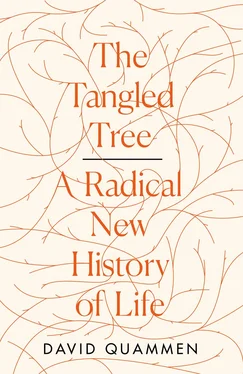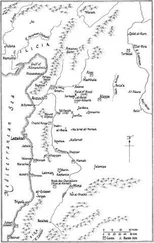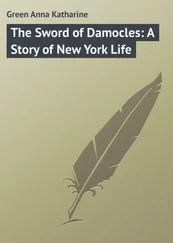Hitchcock’s trees weren’t classically tree shaped, spreading outward into a canopy like a maple or an oak. Each of the two, the one for animals and the one for plants, looks more like a windbreak of tightly placed Lombardy poplars grown to maturity along a roadway. The base of each windbreak is a thick, solid trunk from which rise slender stems, fluffy with foliage but without much branching as they ascend. Vertical, parallel, they seem independent: crustaceans, worms, bivalves, vertebrates. The vertebrate stem does branch into several shafts. The shaft leading up to modern mammals culminates in the word Man , atop which sits a regal crown adorned by a cross.
The crowned “Man,” with its cross, tells us what we need to know about Hitchcock’s sense of hierarchy in the living world. He grounded his geology firmly within the tradition known as natural theology, meaning science purposed to illuminate the power and wisdom of God as creator of all, with humans as the culmination of that divine creativity. He was a devout, driven New England Yankee, and his “Paleontological Chart” reflected his view of humans as the apogee of creation, as well as his findings in geology.
Hitchcock was born to a poor family in Deerfield, Massachusetts, his father a Revolutionary War veteran and a hatter by trade, with debts and three sons, who found just enough money to see his boys through primary school and some time at the local academy. After that, as Hitchcock recalled, “ nothing was before me but a lifeof manual labor.” He balked at the idea of apprenticing as a hatter, to his father, or in any other trade. Instead he worked on a farm—it was rented land, cropped by one of his brothers—for a period that stretched on so long, or what felt like so long, that later he claimed not to remember how many years. With his free time, especially rainy days and evenings, young Edward studied science and the classics. Ambitious and hungry, he thought he was preparing himself for Harvard. Under the influence of an uncle, he took up astronomy. Then came the great comet of 1811, a celestial passerby that reached its peak of brightness in the north sky during autumn that year, when Hitchcock was eighteen. He borrowed some instruments from Deerfield Academy and spent night after night measuring its progress. “ I gave myself to this laborso assiduously that my health failed,” he wrote later.
The health crisis brought on a religious conversion: from Unitarianism, into which he had drifted, back to the Congregationalism of his father. That passed for a drastic rethink in Edward Hitchcock’s life. In lieu of Harvard, he returned to Deerfield and somehow got hired, at age twenty-three, as principal of the academy. Then he studied for the ministry, was ordained, and became pastor of a Congregationalist church in Conway, Massachusetts, just up the road from Deerfield. Throughout these years and for the rest of his life, Hitchcock remained an invalid in self-image if not bodily, obsessed with his own fragility, continually complaining that he felt death nearby, although he lived to be seventy. One scholar, having looked into his life and work, called him “ a hypochondriac of the first rank.”
Hitchcock’s “Paleontological Chart,” 1857 version.
Conveniently for his scientific career, he was “dismissed” from the Conway pastoratein autumn 1825 on the grounds of impaired health and imminent death if (according to his own worried judgment) he didn’t stop preaching, circuiting the parish, and running revivals. Amherst College, recently founded, hired him to teach chemistry and natural history, and he stayed there the rest of his life, serving later as professor of natural theology and geology, and for one nine-year stretch also as president. The early years of Hitchcock’s career at Amherst spanned the period when Charles Lyell, in England, published his multivolume Principles of Geology , a radical work that challenged Scripture-based interpretations of the geological record, including Hitchcock’s own.
The conventional school of thought, known as catastrophism, saw Earth’s history as a series of cataclysmic upheavals cast down like thunderbolts by the Creator, such as the bolt that brought forty days and forty nights of rain, documented in Genesis as Noah’s flood. These catastrophes were considered directional and purposeful, in the sense that God used them as occasions for purging the planet of some creatures (dinosaurs, begone) and adding new creations (mammals, arise). Lyell’s alternative view was uniformitarianism, insisting that the processes and events that shaped Earth in the past were physical, such as erosion and deposition, as well as the occasional volcanic eruption—things that continue to occur in the present at roughly the same rate they did in the past. Those forces caused extinctions, among other effects. Second thoughts by God about what fauna and flora should exist, according to Lyell, did not enter into it.
Hitchcock read Lyell’s work promptly as the first three volumes came out, from 1830 to 1833, and found it all discomforting. He was no young-earth creationist himself; he acknowledged that volcanism and erosion were continuing processes. But he worried that Lyell’s view of the planet would “ exclude a Deity from its creationand government.” In an article on deluges, comparing the biblical with the geological records, Hitchcock wrote cattily: “ We know nothing of Mr. Lyell’s religious creed. But there is something in such an ambiguous mode of treating of scriptural subjects that reminds us of infidel cunning and duplicity.” Lyell was a dutiful Anglican, not an infidel, at least when he authored Principles of Geology , but Hitchcock seems to have sensed, maybe better than Lyell himself, that his work would nudge some readers toward godless, materialistic ideas.
One of those so nudged was Charles Darwin, who read Lyell’s three volumes aboard the Beagle and followed their influence, not just toward uniformitarianism in geology but eventually (because Lyell described Lamarck’s ideas, without endorsing them) toward a theory of evolution. So although Hitchcock was wrong about Lyell’s supposed “cunning and duplicity,” he was right about Principles of Geology taking readers—one crucial reader, anyway—onto a slippery slope.
In 1840, seven years after Lyell’s third volume appeared, Hitchcock published his own Elementary Geology , and with it that Paleontological Chart of Lombardy poplars, included as a hand-colored, foldout figure presenting his two nonevolutionary trees of life. The chart showed changes in Earth’s flora and fauna over geological time, with this or that group of plants or animals waxing or waning in diversity and abundance, but not much branching of one from another. The cause of those changes, Hitchcock explained in his text, was God’s direct agency, adding and subtracting creatures, improving and perfecting the world as a long-term project. The major groups were present all along, according to this slightly tortured schema, but new species manifesting “a higher organization” had been insertedalong the way, until at last Earth was ready for “more perfect” kinds of creatures, “the most generally perfect of all with man at their head.” The gradual introduction of “higher races,” he wrote, “ is perfectly explained by the changing conditionof the earth which being adapted for more perfect races Divine Wisdom introduced them.” These were special creations by the Deity, appropriate as environments changed. God wasn’t rethinking the planet’s fauna and flora, just adjusting them to newly available niches. If that doesn’t quite make sense, don’t blame Charles Lyell or me.
Hitchcock’s Elementary Geology was a hit. Between 1840 and the late 1850s, it went through thirty editions, to which he made minor revisions of language and data. Throughout all those editions, the trees figure remained—unchanged except for color adjustments. Then something happened. As a consequence of that something, or else by improbable coincidence, the thirty-first edition of Hitchcock’s book, in 1860, contained a notable difference. An omission. No trees.
Читать дальше












